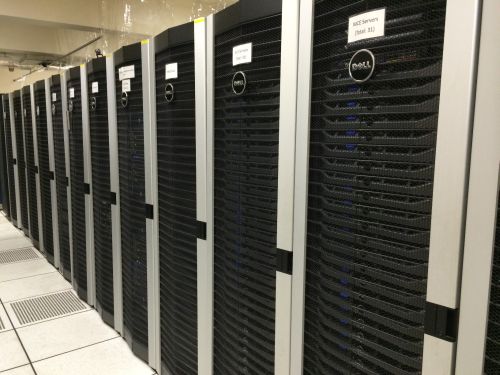The Dwarfs Behind Numerical Weather Prediction
The Dwarfs Behind Numerical Weather Prediction
TSANG Moon-tong
December 2013
How long is the time for a thought? According to Buddhist Scripture, it is around 18 microseconds[1]. Within this tiny period, computing nodes[2] of a high performance computing (HPC) system exchanged data with each other some thousand times or more. Numerical weather prediction (NWP) relies on the cooperation of these computing nodes (Figure 1) to calculate the weather elements in each high-resolution grid of a numerical model.

Figure 1 Computing nodes of the high performance computing system
During calculation, data are exchanged continuously among these nodes. Some temporary data are stored in the Random Access Memory (RAM) of the nodes to support high speed input/output processes. The multi-core Central Processing Units (CPU) of the nodes are operating in full steam to crunch the numbers to complete calculations within a short period of time. The calculation results are fed into the "Parallel File System" of the HPC system for retrieval by other nodes running in parallel. Lastly, the final results will be transformed into graphical charts or data listings for easy viewing.
The dwarf-like nodes work closely with one another, making it possible to quickly generate and print the forecast charts for forecasters' consumption. If any of the dwarfs slows down, possibly caused by hardware or software problems, the whole system may shut down like what happened to Snow White after she had eaten the poisoned apple. At that time, the system administrator will take up the role of the Prince to identify the poisoned apple in the throat of Snow White, then isolate the problematic component and resume the system operation.
The Moore's Law[3] forecasts that the number of transistors on chips of the same size would double every 18 months, thus increasing the computational power by one fold. We can see that those dwarfs behind the new NWP systems will become little supermen after a few years. So what kind of weather forecast charts can these little supermen compute and draw in future?
References:
[1] "The time for a thought", Buddhist Dictionary; "ksana", Wikipedia (both in Chinese only)
[2] Most HPC systems are made up of small computers connected by local area networks for exchange of information. Each of these computers is called a computing node. "Computer Cluster", Wikipedia
[3] "Moore's law", Wikipedia
[1] "The time for a thought", Buddhist Dictionary; "ksana", Wikipedia (both in Chinese only)
[2] Most HPC systems are made up of small computers connected by local area networks for exchange of information. Each of these computers is called a computing node. "Computer Cluster", Wikipedia
[3] "Moore's law", Wikipedia